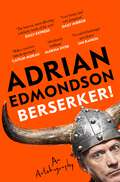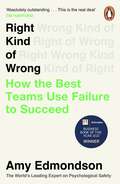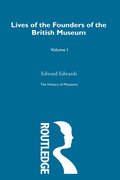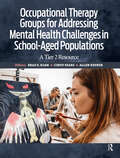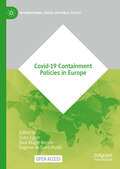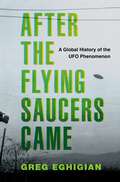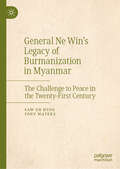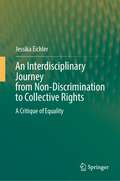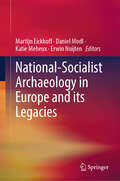- Table View
- List View
Berserker!: The deeply moving and brilliantly funny memoir from one of Britain's most beloved comedians
by Adrian EdmondsonThe instant Sunday Times bestseller and Financial Times Best Audio of 2023From brutal schooldays to 80s anarchy, through The Young Ones, Bottom and beyond, Berserker! is the one-of-a-kind, fascinating memoir from an icon of British comedy, Adrian Edmondson.Ade Edmondson revolutionized the comedy circuit in the 1980s and, alongside Rik Mayall, brought anarchy to stage and screen. How did a child brought up in a strict Methodist household – and who spent his formative years incarcerated in repressive boarding schools – end up joining the revolution?With wisdom, nostalgia and uniquely observed humour, Ade traces his journey through life and comedy: starting out on the alternative scene, getting arrested in Soho, creating outrageously violent characters and learning more about his curious (possibly Scandinavian) heritage. With star-studded anecdotes and set to a soundtrack of pop hits which transport the reader through time, it’s a memoir like no other.Nominated for Radio Times Moment of the Year for sharing his memories of Rik Mayall on Desert Island Discs.'The Berserker from The Young Ones and Bottom tells his story with self-effacing charm and no end of backstage anecdotes' - Ian Rankin'Amazing' - Richard Osman'Gloriously candid and wise all at once' - Sara Pascoe'It is incredibly funny, but it is also a lot, lot more than that' - Miles Jupp‘More fun than reading Hegel, and also more enlightening’ - Louis de Bernières
Right Kind of Wrong: Why Learning to Fail Can Teach Us to Thrive
by Amy EdmondsonWinner of the Financial Times Business Book of the Year Award‘Absolutely outstanding’ Tim Harford, author of The Undercover Economist'A masterclass’ Angela Duckworth, author of Grit‘Excellent’ Andrew Hill, Financial TimesWe used to think of failure as a problem, to be avoided at all costs. Now, we're often told that failure is desirable - that we must ‘fail fast, fail often’. The trouble is, neither approach distinguishes the good failures from the bad. As a result, we miss the opportunity to fail well.Here, Amy Edmondson – the world’s most influential organisational psychologist – reveals how we get failure wrong, and how to get it right. Drawing on four decades of research into the world’s most effective teams, she unveils the three archetypes of failure – basic, complex and intelligent - and explains how to harness the revolutionary potential of the good ones (and eliminate the bad). Along the way, she poses a simple, provocative question: What if it is only by learning to fail that we can hope to truly succeed?‘Lays out a clearer path about how to stop avoiding failure and take smarter risks.’ Books of the Year, Financial Times
Understanding Maritime Security
by Timothy Edmunds Christian BuegerA concise introduction to the history and evolution of security at sea. Whether it is pirates, smugglers, illicit fishing, or disputes in the South China Sea, the oceans are of increasing importance in international security. In Understanding Maritime Security, Christian Bueger and Timothy Edmunds provide a concise introduction to the history of security at sea and explain the core frameworks of analysis that professionals use to understand and tackle challenges to maritime order. They discuss key issues within the maritime security agenda, including inter-state disputes, terrorism, piracy, smuggling, trafficking, and illicit fishing, and examine how states have responded. Bueger and Edmunds analyze future trends and show how maritime security is impacted by the critical infrastructure agenda, emerging technologies, cyber security, climate change, biodiversity loss, and the renaissance of geopolitics. Comprehensive and incisive, this primer of maritime security is essential reading for maritime security professionals and students of this increasingly important issue.
Understanding Maritime Security
by Timothy Edmunds Christian BuegerA concise introduction to the history and evolution of security at sea. Whether it is pirates, smugglers, illicit fishing, or disputes in the South China Sea, the oceans are of increasing importance in international security. In Understanding Maritime Security, Christian Bueger and Timothy Edmunds provide a concise introduction to the history of security at sea and explain the core frameworks of analysis that professionals use to understand and tackle challenges to maritime order. They discuss key issues within the maritime security agenda, including inter-state disputes, terrorism, piracy, smuggling, trafficking, and illicit fishing, and examine how states have responded. Bueger and Edmunds analyze future trends and show how maritime security is impacted by the critical infrastructure agenda, emerging technologies, cyber security, climate change, biodiversity loss, and the renaissance of geopolitics. Comprehensive and incisive, this primer of maritime security is essential reading for maritime security professionals and students of this increasingly important issue.
Predictive HR Analytics: Mastering the HR Metric
by Dr Martin Edwards Kirsten Edwards Daisung JangThis is the essential guide for HR practitioners who want to gain the statistical and analytical knowledge to fully harness the potential of HR metrics and organizational people-related data.The ability to use and analyse data has become an invaluable skill for HR professionals to not only identify trends and patterns, but also make well-informed business decisions. The third edition of Predictive HR Analytics provides a clear, accessible framework for understanding people data, working with people analytics and advanced statistical techniques.Readers will be taken step-by-step through worked examples, showing them how to carry out analyses and interpret HR data in areas such as employee engagement, performance and turnover. Learn how to make effective business decision with this updated edition that includes the latest materials on predicting attrition with machine learning, biased algorithms and data protection, supported by online resources consisting of R and Excel data sets.
Predictive HR Analytics: Mastering the HR Metric
by Dr Martin Edwards Kirsten Edwards Daisung JangThis is the essential guide for HR practitioners who want to gain the statistical and analytical knowledge to fully harness the potential of HR metrics and organizational people-related data.The ability to use and analyse data has become an invaluable skill for HR professionals to not only identify trends and patterns, but also make well-informed business decisions. The third edition of Predictive HR Analytics provides a clear, accessible framework for understanding people data, working with people analytics and advanced statistical techniques.Readers will be taken step-by-step through worked examples, showing them how to carry out analyses and interpret HR data in areas such as employee engagement, performance and turnover. Learn how to make effective business decision with this updated edition that includes the latest materials on predicting attrition with machine learning, biased algorithms and data protection, supported by online resources consisting of R and Excel data sets.
The History of Museums Vol 1
by Edward EdwardsMuseums and collecting is now a major area of cultural studies. This selected group of key texts opens the investigation and appreciation of museum history. Edward Edwards, chief pioneer of municipal public libraries, chronicles the founders and early donors to the British Museum. Greenwood and Murray provide informative pictures of the early history of the museum movement. Sir William Flower, Director of the British Museum (Natural History), takes a pioneering philosophical approach to the sphere of natural history in relation to museums. Similarly, Acland and Ruskin discuss and explore the relationships of art and architecture to museums.
The History of Museums Vol 1: With Notices Of Its Chief Augmentors And Other Benefactors, 1570-1870
by Edward EdwardsMuseums and collecting is now a major area of cultural studies. This selected group of key texts opens the investigation and appreciation of museum history. Edward Edwards, chief pioneer of municipal public libraries, chronicles the founders and early donors to the British Museum. Greenwood and Murray provide informative pictures of the early history of the museum movement. Sir William Flower, Director of the British Museum (Natural History), takes a pioneering philosophical approach to the sphere of natural history in relation to museums. Similarly, Acland and Ruskin discuss and explore the relationships of art and architecture to museums.
The History of Museums Vol 2
by Edward EdwardsMuseums and collecting is now a major area of cultural studies. This selected group of key texts opens the investigation and appreciation of museum history. Edward Edwards, chief pioneer of municipal public libraries, chronicles the founders and early donors to the British Museum. Greenwood and Murray provide informative pictures of the early history of the museum movement. Sir William Flower, Director of the British Museum (Natural History), takes a pioneering philosophical approach to the sphere of natural history in relation to museums. Similarly, Acland and Ruskin discuss and explore the relationships of art and architecture to museums.
The History of Museums Vol 2
by Edward EdwardsMuseums and collecting is now a major area of cultural studies. This selected group of key texts opens the investigation and appreciation of museum history. Edward Edwards, chief pioneer of municipal public libraries, chronicles the founders and early donors to the British Museum. Greenwood and Murray provide informative pictures of the early history of the museum movement. Sir William Flower, Director of the British Museum (Natural History), takes a pioneering philosophical approach to the sphere of natural history in relation to museums. Similarly, Acland and Ruskin discuss and explore the relationships of art and architecture to museums.
Nursing Management of the Neurosurgical Patient: Nursing Management of the Neurosurgical Patient: An Interprofessional Approach- E-BOOK
by Jesse Edwards Newton Mei Lauren Malinowski-Falk Allison M. Lang René DanielUse this new text/reference from a nationally recognized center of excellence to ensure high quality nursing care of neurosurgical patients! Nursing Management of the Neurosurgical Patient: An Interprofessional Approach is a concise new resource for best practices in both neurosurgery-specific nursing care and general hospital care. Topics include everything from preoperative assessment and bedside management to common procedures and pathophysiology of the brain and spine; neurosurgical issues such as diabetes, acute kidney injury, and coronary conditions; and pain management, substance abuse, and rehabilitation. A reader-friendly style includes photos, algorithms, flowcharts, and checklists to make it easy to find essential information quickly. Written by experienced neuroscience nurses and Nurse Practitioners, neurosurgeons, and hospitalist physicians, this book uses a team-based, collaborative approach to neurosurgical nursing care.Team-based, interprofessional collaborative, evidence-based approach provides an in-depth guide to neurosurgical nursing care.Consistent, streamlined format serves well as both a textbook and a reference for clinical settings.Abundant, easy-to-reference algorithms help you respond quickly and effectively to resolve neurosurgical patient problems.Discussion and Nursing Considerations sections are provided in every chapter to describe the practical application of key chapter content.Case study with application-level questions is included in every chapter to help you apply key content to neurosurgical nursing practice.Answer key for each case study is provided in every chapter to reinforce understanding and provide remediation.Interprofessional collaborative authorship provides wide-ranging expertise, with each chapter written by a team consisting of a neuroscience nurse or Nurse Practitioner, a neurosurgeon, and a hospitalist physician.
Hand Grasps and Manipulation Skills: Clinical Perspective of Development and Function
by Sandra J. Edwards Jenna D. McCoy-Powlen Donna Gallen Michelle A. SuarezHand Grasps and Manipulation Skills: Clinical Perspective of Development and Function, Second Edition is an expertly designed and logically organized text that provides an accurate and clear depiction of the development of hand grasps and the taxonomy of functional hand grasp.Hand Grasps and Manipulation Skills, Second Edition by Sandra J. Edwards, Donna B. Gallen, Jenna D. McCoy-Powlen, and Michelle A. Suarez is full of concise and user-friendly text that is written to assist in understanding complex information. The photographs, illustrations and charts have been expanded in this Second Edition and present new content areas for students and clinicians to use in education and practice.Hand Grasps and Manipulation Skills, Second Edition is unique in that it is also the only text on the market that contains this comprehensive pictorial information about hands and their grasps. Additional unique features include rare information about in utero development of the hand, left handedness, scissor skill development, in hand manipulation skills, and extensive information regarding clinical application. Hand Grasps and Manipulation Skills, Second Edition is a text that can be used as a career long reference. It provides all the pertinent and comprehensive information for students to learn about the development of the hand in one place, and is expertly and thoroughly referenced with the latest research.Hand Grasps and Manipulation Skills: Clinical Perspective of Development and Function, Second Edition provides clear information on a very specific subject, which makes it the ideal reference for occupational therapy professors, students and clinicians; mechanical engineers, computer software instructors, and engineers working in robotics; medical students and orthopedic hand surgeons.
Hand Grasps and Manipulation Skills: Clinical Perspective of Development and Function
by Sandra J. Edwards Jenna D. McCoy-Powlen Donna Gallen Michelle A. SuarezHand Grasps and Manipulation Skills: Clinical Perspective of Development and Function, Second Edition is an expertly designed and logically organized text that provides an accurate and clear depiction of the development of hand grasps and the taxonomy of functional hand grasp.Hand Grasps and Manipulation Skills, Second Edition by Sandra J. Edwards, Donna B. Gallen, Jenna D. McCoy-Powlen, and Michelle A. Suarez is full of concise and user-friendly text that is written to assist in understanding complex information. The photographs, illustrations and charts have been expanded in this Second Edition and present new content areas for students and clinicians to use in education and practice.Hand Grasps and Manipulation Skills, Second Edition is unique in that it is also the only text on the market that contains this comprehensive pictorial information about hands and their grasps. Additional unique features include rare information about in utero development of the hand, left handedness, scissor skill development, in hand manipulation skills, and extensive information regarding clinical application. Hand Grasps and Manipulation Skills, Second Edition is a text that can be used as a career long reference. It provides all the pertinent and comprehensive information for students to learn about the development of the hand in one place, and is expertly and thoroughly referenced with the latest research.Hand Grasps and Manipulation Skills: Clinical Perspective of Development and Function, Second Edition provides clear information on a very specific subject, which makes it the ideal reference for occupational therapy professors, students and clinicians; mechanical engineers, computer software instructors, and engineers working in robotics; medical students and orthopedic hand surgeons.
The Oxford Handbook of the Merovingian World (Oxford Handbooks)
by Bonnie Effros Isabel MoreiraThe Merovingian era is one of the best studied yet least well known periods of European history. From the fifth to the eighth centuries, the inhabitants of Gaul (what now comprises France, southern Belgium, Luxembourg, Rhineland Germany, and part of modern Switzerland), a mix of Gallo-Roman inhabitants and Germanic arrivals under the political control of the Merovingian dynasty, sought to preserve, use, and reimagine the political, cultural, and religious power of ancient Rome while simultaneously forging the beginnings of what would become medieval European culture. The forty-six essays included in this volume highlight why the Merovingian era is at the heart of historical debates about what happened to Western Europe after the fall of the Roman Empire. The essays demonstrate that the inhabitants of the Merovingian kingdoms in these centuries created a culture that was the product of these traditions and achieved a balance between the world they inherited and the imaginative solutions they bequeathed to Europe. The Handbook highlights new perspectives and scientific approaches that shape our changing view of this extraordinary era by showing that Merovingian Gaul was situated at the crossroads of Europe, connecting the Mediterranean and the British Isles with the Byzantine empire, and it benefited from the global reach of the late Roman Empire. It tells the story of the Merovingian world through archaeology, bio-archaeology, architecture, hagiographic literature, history, liturgy, visionary literature and eschatology, patristics, numismatics, and material culture.
Occupational Therapy Groups for Addressing Mental Health Challenges in School-Aged Populations: A Tier II Resource
by Brad Egan Cindy Sears Allen KeenerA new resource for school-based occupational therapists, Occupational Therapy Groups for Addressing Mental Health Challenges in School-Aged Populations: A Tier 2 Resource is a collection of occupation-based group interventions and tools that can be used to support students at risk for or with identified mental health challenges.School-wide mental health programs are increasing and expanding. School-based occupational therapists are uniquely positioned to collaborate with traditional school mental health practitioners and provide an occupational perspective on how mental health can impact school performance and participation in academic occupations.Occupational Therapy Groups for Addressing Mental Health Challenges in School-Aged Populations is organized into different sections to assist the occupational therapy practitioner or occupational therapy student in considering different aspects of providing mental health services in schools. The text serves as a flexible compendium of group activities and interventions designed to promote positive mental health for all students and support students at risk for or with identified mental health challenges.What’s included in Occupational Therapy Groups for Addressing Mental Health Challenges in School-Aged Populations: Cases to help recognize the occupational impact of internalizing and externalizing behaviors A quick reference of common assessments and screening tools Occupation-based Tier 2 group protocols and data collection tool templates An online section for occupational therapy and occupational therapy assistant educators with ideas for learning assignments, rubrics, and classroom activities to prepare prelicensure learners for addressing school mental health needs once they enter practice Occupational Therapy Groups for Addressing Mental Health Challenges in School-Aged Populations: A Tier 2 Resource expresses the valued contribution that occupational therapists make to school mental health initiatives while also addressing a major gap—a Tier 2–focused resource with intervention ideas and tools for answering this urgent call to practice.
Occupational Therapy Groups for Addressing Mental Health Challenges in School-Aged Populations: A Tier II Resource
by Brad Egan Cindy Sears Allen KeenerA new resource for school-based occupational therapists, Occupational Therapy Groups for Addressing Mental Health Challenges in School-Aged Populations: A Tier 2 Resource is a collection of occupation-based group interventions and tools that can be used to support students at risk for or with identified mental health challenges.School-wide mental health programs are increasing and expanding. School-based occupational therapists are uniquely positioned to collaborate with traditional school mental health practitioners and provide an occupational perspective on how mental health can impact school performance and participation in academic occupations.Occupational Therapy Groups for Addressing Mental Health Challenges in School-Aged Populations is organized into different sections to assist the occupational therapy practitioner or occupational therapy student in considering different aspects of providing mental health services in schools. The text serves as a flexible compendium of group activities and interventions designed to promote positive mental health for all students and support students at risk for or with identified mental health challenges.What’s included in Occupational Therapy Groups for Addressing Mental Health Challenges in School-Aged Populations: Cases to help recognize the occupational impact of internalizing and externalizing behaviors A quick reference of common assessments and screening tools Occupation-based Tier 2 group protocols and data collection tool templates An online section for occupational therapy and occupational therapy assistant educators with ideas for learning assignments, rubrics, and classroom activities to prepare prelicensure learners for addressing school mental health needs once they enter practice Occupational Therapy Groups for Addressing Mental Health Challenges in School-Aged Populations: A Tier 2 Resource expresses the valued contribution that occupational therapists make to school mental health initiatives while also addressing a major gap—a Tier 2–focused resource with intervention ideas and tools for answering this urgent call to practice.
Covid-19 Containment Policies in Europe (International Series on Public Policy)
by Clara Egger Raul Magni-Berton Eugénie de Saint-PhalleThis open access book examines the diverse strategies implemented by national and local European governments to contain the Covid-19 pandemic. Rather than focus on individual national case studies, it brings together leading scholars and policymakers to analyse the wide range of containment policies utilised across the continent at various levels of government. In doing so, the volume assesses Covid-19 crisis-management experiences to identify good practices based on comparative and fine-grained evidence. It argues that such a stock-taking exercise is crucial to better prepare European polities and societies for future crises, including climate change and environmental disasters. The book will appeal to scholars and students of public policy, crisis-management, public administration, international relations and comparative law.
After the Flying Saucers Came: A Global History of the UFO Phenomenon
by Greg EghigianRoswell, 1947. Washington, DC, 1952. Quarouble, 1954. New Hampshire, 1961. Pascagoula, 1973. Petrozavodsk, 1977. Copley Woods, 1983. Explore how sightings of UFOs and aliens seized the world's attention and discover what the fascination with flying saucers and extraterrestrial visitors says about our changing views on science, technology, and the paranormal. In the summer of 1947, a private pilot flying over the state of Washington saw what he described as several pie pan-shaped aircraft traveling in formation at remarkably high speed. Within days, journalists began referring to the objects as "flying saucers." Over the course of that summer, Americans reported seeing them in the skies overhead. News quickly spread, and within a few years, flying saucers were being spotted across the world. The question on everyone's mind was, what were they? Some new super weapon in the Cold War? Strange weather patterns? Optical illusions? Or perhaps it was all a case of mass hysteria? Some, however, concluded they could only be one thing: spacecrafts built and piloted by extraterrestrials. The age of the unidentified flying object, the UFO, had arrived. Greg Eghigian tells the story of the world's fascination with UFOs and the prospect that they were the work of visitors from outer space. While accounts of great wonders in the sky date back to antiquity, reports of UFOs took place against the unique backdrop of the Cold War and space age, giving rise to disputed government inquiries, breathtaking news stories, and single-minded sleuths. After the Flying Saucers Came traces how a seemingly isolated incident sparked an international drama involving shady figures, questionable evidence, suspicions of conspiracy, hoaxes, new religions, scandals, unsettling alien encounters, debunkers, and celebrities. It examines how descriptions, theories, and debates about unidentified flying objects and alien abduction changed over time and how they appeared in the United States, Europe, Latin America, Asia, and Russia. And it explores the impact UFOs have had on our understanding of space, science, technology, and ourselves up through the present day. Replete with stories of the people who have made up the ufology community, the military and defense units that investigate them, the scientists and psychologists who have researched these unexplained encounters, and the many novels, movies, TV shows, and websites that have explored these phenomena, After the Flying Saucers Came speaks to believers and skeptics alike.
After the Flying Saucers Came: A Global History of the UFO Phenomenon
by Greg EghigianRoswell, 1947. Washington, DC, 1952. Quarouble, 1954. New Hampshire, 1961. Pascagoula, 1973. Petrozavodsk, 1977. Copley Woods, 1983. Explore how sightings of UFOs and aliens seized the world's attention and discover what the fascination with flying saucers and extraterrestrial visitors says about our changing views on science, technology, and the paranormal. In the summer of 1947, a private pilot flying over the state of Washington saw what he described as several pie pan-shaped aircraft traveling in formation at remarkably high speed. Within days, journalists began referring to the objects as "flying saucers." Over the course of that summer, Americans reported seeing them in the skies overhead. News quickly spread, and within a few years, flying saucers were being spotted across the world. The question on everyone's mind was, what were they? Some new super weapon in the Cold War? Strange weather patterns? Optical illusions? Or perhaps it was all a case of mass hysteria? Some, however, concluded they could only be one thing: spacecrafts built and piloted by extraterrestrials. The age of the unidentified flying object, the UFO, had arrived. Greg Eghigian tells the story of the world's fascination with UFOs and the prospect that they were the work of visitors from outer space. While accounts of great wonders in the sky date back to antiquity, reports of UFOs took place against the unique backdrop of the Cold War and space age, giving rise to disputed government inquiries, breathtaking news stories, and single-minded sleuths. After the Flying Saucers Came traces how a seemingly isolated incident sparked an international drama involving shady figures, questionable evidence, suspicions of conspiracy, hoaxes, new religions, scandals, unsettling alien encounters, debunkers, and celebrities. It examines how descriptions, theories, and debates about unidentified flying objects and alien abduction changed over time and how they appeared in the United States, Europe, Latin America, Asia, and Russia. And it explores the impact UFOs have had on our understanding of space, science, technology, and ourselves up through the present day. Replete with stories of the people who have made up the ufology community, the military and defense units that investigate them, the scientists and psychologists who have researched these unexplained encounters, and the many novels, movies, TV shows, and websites that have explored these phenomena, After the Flying Saucers Came speaks to believers and skeptics alike.
Orthopedic Residency and Fellowship: A Guide to Success
by Kenneth Egol Joseph Zuckerman Laith JazrawiOrthopedic surgery remains one of the most competitive subspecialties in medicine. This “how- to” guide describes how medical students can achieve their goal of being accepted into an orthopedic residency program and how to thrive once there.What will you learn from Orthopedic Residency and Fellowship: A Guide to Success?• How medical students can achieve their goal of being accepted into an orthopedic residency program• How to succeed during and after your residency• Tips and pearls to maximize your experience• Budgeting your time• Peer interaction• Job placement• How to read a contract• How to decide between academic or private practice• Asset protection • Making the right financial decisionOrthopedic Residency and Fellowship: A Guide to Success by Drs. Laith M. Jazrawi, Kenneth A. Egol and Joseph D. Zuckerman is the only book on the market that solely focuses on getting into an orthopedic residency or fellowship training program, excelling once you are there, and maximizing and obtaining the right practice opportunity for you. Providing easy-to-read chapters and quick reference materials, this book is a must-read for anyone interested in the field of musculoskeletal care.
Orthopedic Residency and Fellowship: A Guide to Success
by Kenneth Egol Joseph Zuckerman Laith JazrawiOrthopedic surgery remains one of the most competitive subspecialties in medicine. This “how- to” guide describes how medical students can achieve their goal of being accepted into an orthopedic residency program and how to thrive once there.What will you learn from Orthopedic Residency and Fellowship: A Guide to Success?• How medical students can achieve their goal of being accepted into an orthopedic residency program• How to succeed during and after your residency• Tips and pearls to maximize your experience• Budgeting your time• Peer interaction• Job placement• How to read a contract• How to decide between academic or private practice• Asset protection • Making the right financial decisionOrthopedic Residency and Fellowship: A Guide to Success by Drs. Laith M. Jazrawi, Kenneth A. Egol and Joseph D. Zuckerman is the only book on the market that solely focuses on getting into an orthopedic residency or fellowship training program, excelling once you are there, and maximizing and obtaining the right practice opportunity for you. Providing easy-to-read chapters and quick reference materials, this book is a must-read for anyone interested in the field of musculoskeletal care.
General Ne Win’s Legacy of Burmanization in Myanmar: The Challenge to Peace in the Twenty-First Century
by Saw Eh Htoo Tony WatersThis book focuses on how Burmanization created and reinforced ethnic divides since the 1962 coup d’etat. when General Ne Win concentrated all authority in the Burmese speaking army. Background research for the book includes Burmese language materials from the Burmese Socialist Party (BSP) and others that describe with what the BSP believed in their own terms. This is unique from previous works on the topic which either simply pointed out that the policies “didn’t work” and therefore are uninteresting, or to claim that they were “necessary” given the chaos of the previous regime. The authors agree that Ne Win’s policies “didn’t work.” However, the book goes further by elaborating why Burmanization policies developed in the 1960s are important for understanding Burmese society today. Most importantly, Ne Win’s ideology reflects how patterns of interethnic relationships in Myanmar lead to the “intractability” of the battles in early twenty-first century Myanmar.
Politische Theorie des Anarchismus: Zum paradoxen Streben nach Autonomie, Selbstbestimmung und Selbstorganisation (Edition Politik #168)
by Jonathan EibischDer anarchistische Politikbegriff erscheint widersprüchlich: Der Ablehnung von Politik steht eine Bezugnahme auf sie gegenüber. Diese Paradoxie entspringt einer bestimmten Denkweise, die dabei hilft, Netzwerke zwischen verschiedenen Strömungen, Gruppen und Diskursen zu weben. So eröffnet sich die Möglichkeit, auf widersprüchliche gesellschaftliche Verhältnisse zu antworten, um sie zu überschreiten. Dies zeigt sich im Modus des Strebens nach Autonomie, in Kontroversen zwischen Individualismus und Kollektivismus und in theoretischen Konzepten wie der sozialen Revolution. In diesem Kontext verdeutlicht Jonathan Eibisch, dass es eine zeitgemäße politische Theorie des Anarchismus gibt - und wie sie aussehen kann.
An Interdisciplinary Journey from Non-Discrimination to Collective Rights: A Critique of Equality
by Jessika EichlerThis book develops a critique of the equality paradigms and principles to be found in the majority of today’s legal orders. It accompanies the reader taking her/him/x from a critique of non-discrimination and equality to the ‘opposite’ end of the spectrum, that is, to collective rights, collectivization processes and a manifestation of recognition that is based on difference. This interdisciplinary, theoretical journey explores a multiplicity of (legal) orders in terms of how they provide spaces of articulation for ‘difference’. The book draws, emblematically, on the rights of indigenous peoples as well as recognized and unrecognized cultural, ethnic, linguistic and religious minorities. The book thereby builds on legal and political theory, which ultimately proves essential given the dedicated objective of the book, that is, to introduce a variety of recognition principles and what the author terms ‘scales of collectivization’, which facilitate a better understanding of collective rights and further ways to capture, define and ultimately measure these rights.
National-Socialist Archaeology in Europe and its Legacies
by Martijn Eickhoff Daniel Modl Katie Meheux Erwin NuijtenThis edited volume is dedicated to national-socialist archaeology as a Europe-wide phenomenon. It analyses national-socialist attempts to denationalize the archaeologies of European nations by creating a new unifying European archaeology on a racial basis. From the beginning of the nineteenth century, archaeology began to develop into an important force behind processes of nation building. At the same time, structures of transnational academic collaboration contributed strongly to the internal dynamics of the research field, which was primarily organized on a national basis. In those European countries that were confronted with national-socialist occupation and repression between 1939 and 1945, these transnational archaeological networks were to prove crucial for the development of national-socialist archaeological policies. This volume will reveal how national-socialist archaeology was to anextent valued positively in its time as highly innovative, even influencing the archaeology of non-occupied countries. Although in the final instance, it generally failed to displace the national archaeologies in Europe, the volume also analyses the long-term impact of national-socialist rule on the development of European archaeology. How did the attempts to create a unified European archaeology after 1945 continue to influence networks, methods and terminologies, institutional structures, or popular representations of the early past? Chapter “1” Is available open access under a Creative Commons Attribution 4.0 International License via Springerlink.
